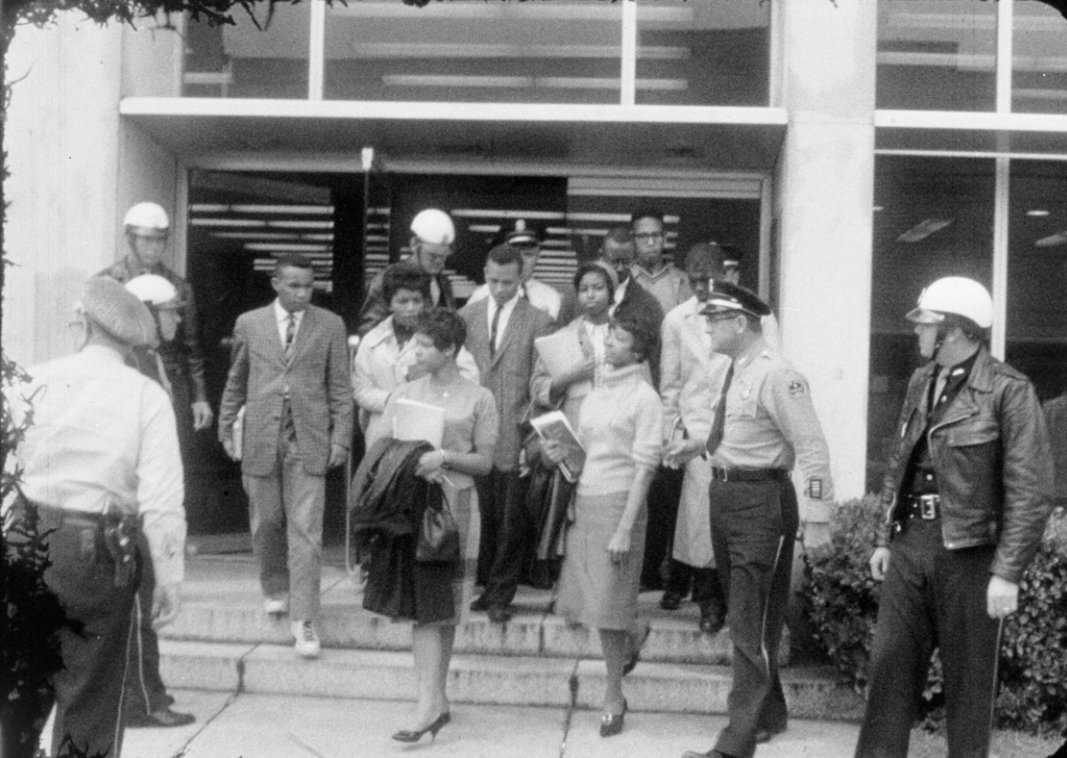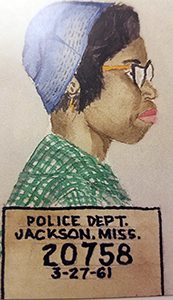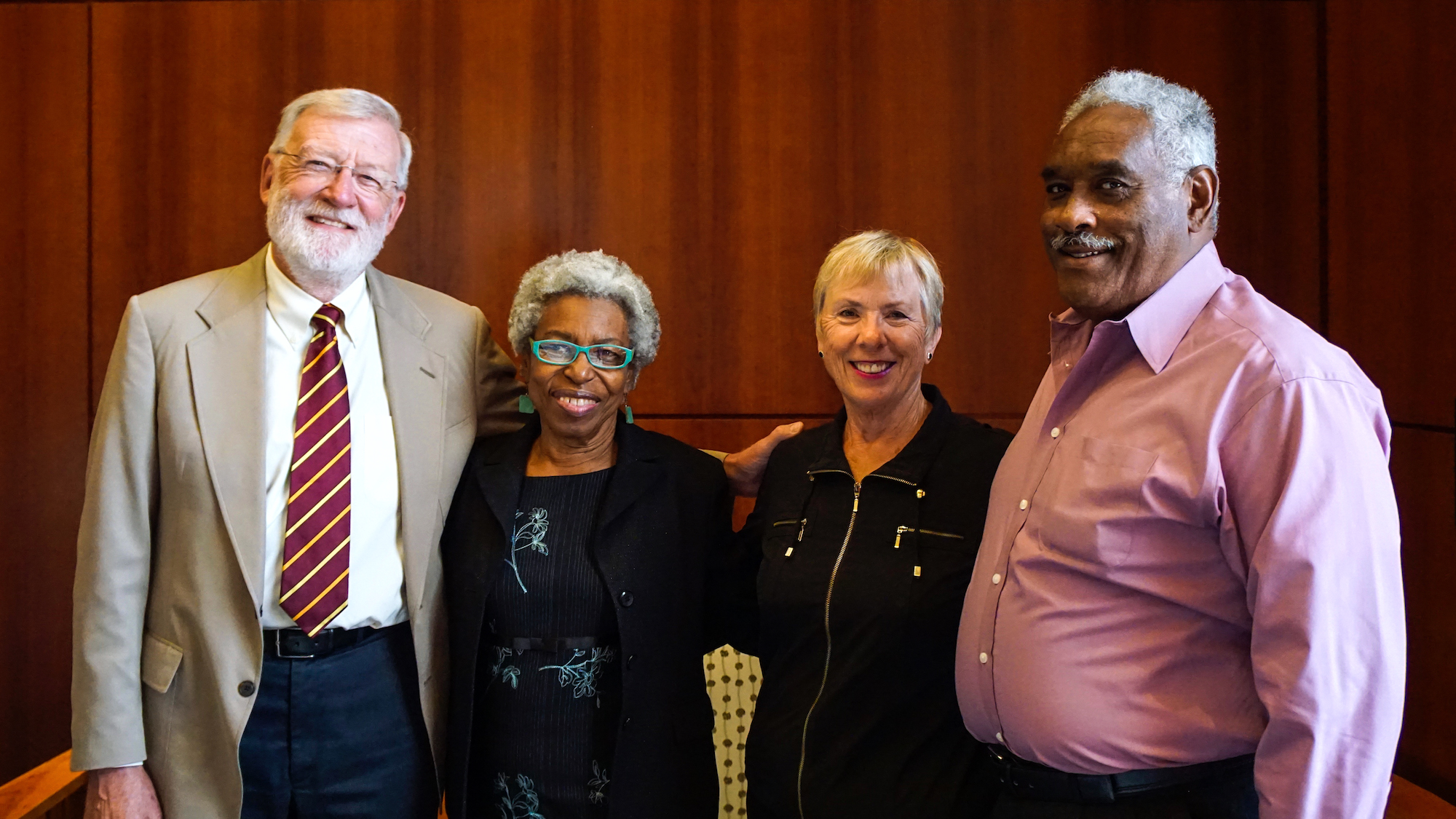
The Tougaloo Nine are escorted from the Jackson Public Library in 1961
Most of us think about Rosa Parks refusing to give up her seat or Martin Luther King Jr.’s March on Washington when we think about the civil rights movement. Lesser known is the issue of library segregation, and the profound lengths that college-aged students went to in order to integrate them.
Geraldine Edwards Hollis was one of these students. In 1961, she and eight other students from historically-black Tougaloo College — a group known as the Tougaloo Nine — held a sit-in at a “whites-only” public library in Jackson, Mississippi, as an act of civil disobedience.
“I knew it could have been death or dogs … but I made that choice because I knew that somebody had to do it,” says Geraldine. She attributes the group’s success to three key things. “Treating people kind, working with love, and having expectations for yourself and for others makes a lot of things happen.” Geraldine strongly recommends this approach to young activists.
Nonviolence was, in fact, one of the defining features of the Tougaloo Nine’s protests. “During that time, we wanted to do everything nonviolent. That meant that we had to work at experiencing things that would make us violent and … restrain ourselves.”

An illustration of Geraldine Hollis's mugshot after her arrest for sitting in at a white library
Jim Crow laws were maintained through violence which, Geraldine notes, only created more violence. When the Tougaloo Nine peacefully sat in at the Jackson Municipal Library, they did more than attempt to integrate it.
“What we did was something that opened up not just the libraries, but the hearts and minds of the people in Mississippi,” Geraldine revealed at the SCU Library’s fall Book of the Quarter event in October. Through widespread local media coverage, they caused people to reflect on the ethics of codified racial segregation. Yet their work went largely unnoticed until library historians like Dr. Wayne Wiegand, Professor Emeritus of Library and Information Sciences at Florida State University, began talking about it.
“The profession itself doesn’t know the story,” Wayne recounted at the Book of the Quarter event. In June 2018, the American Library Association (ALA) passed a resolution to finally acknowledge the work of the countless protestors who fought to integrate libraries. “When that ALA resolution was passed, [many librarians in attendance] turned to each other and said, ‘I never knew this at all. I didn’t know this about librarianship.’”
The ALA’s acceptance of racial segregation at the time was obscured by a clause in the ALA’s 1939 Library Bill of Rights which states, “A person’s right to use a library should not be denied or abridged because of origin, age, background, or views.” Without knowing the full history of discrimination in Southern libraries, many library professionals assume that the organization was ahead of its time in promoting inclusion.
“The rhetoric doesn’t always match the reality,” Wayne said. Most Southern librarians at the time agreed with Jim Crow laws, but there were notable dissenters. Eric Moon, the editor of Library Journal, wrote about his detest for segregated libraries even when it jeopardized his career. During the Montgomery bus boycotts, a librarian wrote a letter to the local newspaper saying she deplored the behavior of bus drivers towards black people. She lost her job for speaking out, which served as a warning for other white librarians not to get involved. As a result, some librarians at segregated libraries silently protested by resigning, or covertly helping black people, who sometimes had to sneak in the back entrance just to check out books.
One such librarian in Mississippi received a letter from a black woman in her community who wanted to start a public library. On her official stationery she responded “No, I cannot help you,” but she wrote on her personal stationery, “I’ll help you in any way I can.”
These are the unspoken stories of the Jim Crow era. What might reconciliation look like today? For Wayne, it means communities where segregated libraries existed should recognize the injustices that took place. He and his wife, Dr. Shirley Wiegand, a professor at Marquette University Law School, travel to these communities to give talks about their 2018 book The Desegregation of Public Libraries in the Jim Crow South: Civil Rights and Local Activism. They encourage local governments to put up plaques in honors of the protestors.
“The public doesn’t know about this because libraries never covered it and people would think that libraries have always been integrated because of that rhetoric of theirs,” Shirley says. “Enough time has passed that people can talk about it and begin to recognize that a lot of those protestors are dying off ... so now is the time to give them some recognition.”
Geraldine believes it’s important to recognize the many forms of discrimination that still exist today, such as systematic biases against people of color in the workplace. “If you’re closed out because of the color of your skin, the texture of your hair … then you’re not going to have a chance to have that opportunity.”
Geraldine’s lessons from that time hold contemporary meaning. Racial prejudice is still a fraught issue in today’s America. In some cases, discrimination looks exactly the same as it always has, and in others it takes on new faces. Both are dangerous, but the latter is more insidious because it isn’t always obvious. Geraldine stresses this to the next generation of young activists: “It’s what they don’t see that they’re missing.”

Wayne Wiegand, Geraldine Edwards Hollis, Shirley Wiegand, and Jack Hollis reunite at the Library's Fall Book of the Quarter event